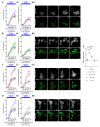Multiple Sclerosis-Associated hnRNPA1 Mutations Alter hnRNPA1 Dynamics and Influence Stress Granule Formation
- PMID: 33809384
- PMCID: PMC7998649
- DOI: 10.3390/ijms22062909
Multiple Sclerosis-Associated hnRNPA1 Mutations Alter hnRNPA1 Dynamics and Influence Stress Granule Formation
Abstract
Evidence indicates that dysfunctional heterogeneous ribonucleoprotein A1 (hnRNPA1; A1) contributes to the pathogenesis of neurodegeneration in multiple sclerosis. Understanding molecular mechanisms of neurodegeneration in multiple sclerosis may result in novel therapies that attenuate neurodegeneration, thereby improving the lives of MS patients with multiple sclerosis. Using an in vitro, blue light induced, optogenetic protein expression system containing the optogene Cryptochrome 2 and a fluorescent mCherry reporter, we examined the effects of multiple sclerosis-associated somatic A1 mutations (P275S and F281L) in A1 localization, cluster kinetics and stress granule formation in real-time. We show that A1 mutations caused cytoplasmic mislocalization, and significantly altered the kinetics of A1 cluster formation/dissociation, and the quantity and size of clusters. A1 mutations also caused stress granule formation to occur more quickly and frequently in response to blue light stimulation. This study establishes a live cell optogenetics imaging system to probe localization and association characteristics of A1. It also demonstrates that somatic mutations in A1 alter its function and promote stress granule formation, which supports the hypothesis that A1 dysfunction may exacerbate neurodegeneration in multiple sclerosis.
Keywords: hnRNPA1; multiple sclerosis; mutations; optogenetics; stress granules.
Conflict of interest statement
The authors of this study have no current or past relationships with commercial entities, and the information contained within is not currently nor previously funded by commercial entities.
Figures





Similar articles
-
Genotype-phenotype association and functional analysis of hnRNPA1 mutations in amyotrophic lateral sclerosis.Amyotroph Lateral Scler Frontotemporal Degener. 2024 Aug;25(5-6):600-607. doi: 10.1080/21678421.2024.2346502. Epub 2024 May 8. Amyotroph Lateral Scler Frontotemporal Degener. 2024. PMID: 38717009
-
Molecular epidemiological study of familial amyotrophic lateral sclerosis in Japanese population by whole-exome sequencing and identification of novel HNRNPA1 mutation.Neurobiol Aging. 2018 Jan;61:255.e9-255.e16. doi: 10.1016/j.neurobiolaging.2017.08.030. Epub 2017 Sep 6. Neurobiol Aging. 2018. PMID: 29033165
-
Dysfunctional RNA binding proteins and stress granules in multiple sclerosis.J Neuroimmunol. 2018 Nov 15;324:149-156. doi: 10.1016/j.jneuroim.2018.08.015. Epub 2018 Aug 29. J Neuroimmunol. 2018. PMID: 30190085
-
Complex interaction between mutant HNRNPA1 and gE of varicella zoster virus in pathogenesis of multiple sclerosis.Autoimmunity. 2018 Jun;51(4):147-151. doi: 10.1080/08916934.2018.1482883. Epub 2018 Jul 11. Autoimmunity. 2018. PMID: 29996671 Review.
-
Clinical heterogeneity in a family with flail arm syndrome and review of hnRNPA1-related spectrum.Ann Clin Transl Neurol. 2022 Dec;9(12):1910-1917. doi: 10.1002/acn3.51682. Epub 2022 Oct 31. Ann Clin Transl Neurol. 2022. PMID: 36314424 Free PMC article. Review.
Cited by
-
Cross-Effects in Folding and Phase Transitions of hnRNP A1 and C9Orf72 RNA G4 In Vitro.Molecules. 2024 Sep 14;29(18):4369. doi: 10.3390/molecules29184369. Molecules. 2024. PMID: 39339364 Free PMC article.
-
RNA-binding proteins as a common ground for neurodegeneration and inflammation in amyotrophic lateral sclerosis and multiple sclerosis.Front Mol Neurosci. 2023 Jul 4;16:1193636. doi: 10.3389/fnmol.2023.1193636. eCollection 2023. Front Mol Neurosci. 2023. PMID: 37475885 Free PMC article. Review.
-
Pro-Inflammatory Cytokines and Antibodies Induce hnRNP A1 Dysfunction in Mouse Primary Cortical Neurons.Brain Sci. 2021 Sep 28;11(10):1282. doi: 10.3390/brainsci11101282. Brain Sci. 2021. PMID: 34679349 Free PMC article.
-
A focus on the normal-appearing white and gray matter within the multiple sclerosis brain: a link to smoldering progression.Acta Neuropathol. 2025 Aug 10;150(1):16. doi: 10.1007/s00401-025-02923-1. Acta Neuropathol. 2025. PMID: 40783892 Free PMC article. Review.
-
Knock-Down of Heterogeneous Nuclear Ribonucleoprotein A1 Results in Neurite Damage, Altered Stress Granule Biology, and Cellular Toxicity in Differentiated Neuronal Cells.eNeuro. 2021 Nov 18;8(6):ENEURO.0350-21.2021. doi: 10.1523/ENEURO.0350-21.2021. Print 2021 Nov-Dec. eNeuro. 2021. PMID: 34697074 Free PMC article.
References
MeSH terms
Substances
Grants and funding
LinkOut - more resources
Full Text Sources
Other Literature Sources
Medical
Research Materials

